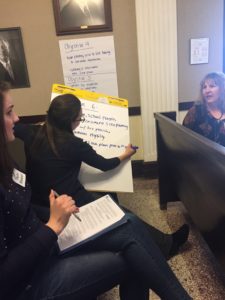
Last month, I traveled with my staff to lead a three-day site visit in a Missouri district located about two hours northeast of Kansas City. Driving past acres of amber waves of grains, I was drawn to the rural landscape. I was delighted by murals dotting the town of Chillicothe, immortalizing their claim as “The Home of Sliced Bread,” and I marveled at Linn County’s turn-of-the-century courthouse. As an outsider in a community that was so different from my own, I couldn’t help but reflect on the vast and rich diversity of our country.

We are a nation that shares common values, laws, rights, and responsibilities, but each of our communities is unique and distinct. A recognition and respect for each community’s singularity is at the core of our initiative’s philosophy.
Our visit to Missouri was part of our project to provide training and technical assistance on the Juvenile Drug Treatment Court Guidelines to court programs around the country. The Guidelines outline policies and practices that are evidence-based and have yielded positive outcomes for youth with substance use disorders. They present a framework of a court that is youth-centered, treatment-focused, and provides equal access for all participants. Aligning with the Guidelines should be the goal of every juvenile drug treatment court, but the way they are implemented is going to differ from court to court. Because the needs of every community are different, the steps a court takes to bring its practices into alignment with the Guidelines is going to be different.
We believe that the communities we serve are the experts on their own needs and their own strengths, and we work with juvenile drug treatment court program staff to develop specific solutions that are right for them. Our aim is not to prescribe a generic model to courts; our role is to create an empowering space and the tools needed for programs to take self-directed action toward alignment with the Guidelines. We encourage the effort to extend well beyond the court core staff and beyond the courthouse walls. The court is just one part of a wider community, and having diverse perspectives incorporated into the strategic planning process is essential. Varied stakeholders provide access to untapped resources, add depth and nuance to the perspectives voiced, and challenge long-held assumptions: all key components to making sustainable changes to better serve the community.
We saw all these components and more in action during our visit to Missouri. We led an incredibly collaborative core team in brainstorming new methods for assessment and screening, new funding sources for youth defense representation, and new supportive, strengths-based program features. We also invited new stakeholders to the table to share their insights into the specific challenges of serving youth.


The conversations around change are hard. Charting a new path forward is daunting. But we left our visit to Missouri confident that we are bound by the same goal, and the same values: We want young people to live happy and full lives with the support they need. Ultimately, this is what drives our initiative.
Zoë Root is the project director of the Juvenile Drug Treatment Court Training and Technical Assistance Initiative (JDTC TTA).
